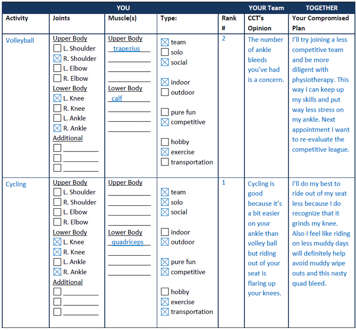As a person with hemophilia, it is important to be physically active and keep your joints and muscles strong. Physical activity helps improve your overall fitness too; it is proven to reduce the risk of obesity, heart conditions and many other health complications. Your physiotherapist can teach you some warm up and cool down exercises to keep your muscles and joints healthy.
Keeping active helps your mental well-being and strengthens social skills
Exercise increases the level of hormones that make you feel happy (endorphins) in your body. You also improve your social skills by engaging in activities with your friends and participating in team sports. Learning how to cooperate with others to achieve a common goal can be one of the most valuable life-skills to master.
Deciding about sports and your hemophilia
Depending on the severity of your bleeding disorder, your family or comprehensive care team (CCT) may want you to be cautious about participating in certain activities. As you become more independent, these decisions will be up to you, so it’s important to think about the risks and make informed decisions.
Some physical activities have a higher risk of injury than others. Sport injuries can cause serious joint and muscle bleeds, especially if your hemophilia is severe. The tricky part is finding a balance so that you are maintaining your fitness level, but not causing joint damage via overuse or internal bleeding. You can ask the staff at your CCT for help in making these decisions. They will help you think about possible risks and give advice on how to prepare. The Canadian Hemophilia Society has a helpful website that ranks common sports by their degree of stress on the body.
Make an Activity Decision Chart
If you are bleeding into joints that you use a lot while playing a particular sport, it may be time to reconsider. Keeping track of how each sport affects your joints, will help you gauge what activities are working for you and when it may be time to slow down. One way to help you decide when it's time for you to modify or reconsider playing a sport is to create an activity decision chart. When making the chart, include the following points for each sport you play.
- List the joints and muscles you use most.
- Of these joints, circle the ones where you have existing issues. For example, circle the joints where the activity has caused severe bleeds.
- Check off all of the different ways you participate in that activity. This includes whether it is:
- solo, team or recreational sport
- indoor or outdoor sport
- competitive or non-competitive
- a hobby, exercise or means of transportation, for instance.
- Rank all of the activities in order from most loved to least loved.
- Bring that list to your CCT and talk about it with them.
- With the advice of CCT in mind, write down your plan.
Below is an example of how you would fill out the chart for volleyball and cycling. Both you and your CCT fill everything in blue. This is why keeping good records of your hemophilia is useful. You and your CCT can now tweak your activities or treatment protocol so that you can still play without compromising your joints.

You can fill in your own activity chart here: Hemophilia Activity Decision Chart
Keeping your joints healthy
You need to maintain some level of activity to keep your joints healthy. Do the exercises you learn in physiotherapy programs from clinic so your joints are able to handle the rigours of sport. If you don’t keep active, your joints may be less forgiving as you age.
At the same time, it is important not to over-work your joints. Playing sports vigorously may cause more damage to your joints in the long run. But by making minor adjustments, you can still participate in the activities you love.
- Consider changing some aspect of the activity to make it easier on your body. For example, lowering the volleyball net means you won’t have to jump as high. This way there is less force on your ankle when you land.
- A lot of sports have rules that can be changed or adapted. For example, many contact sports are now being played with two hand touch, or flags instead of tackling.
- Play less frequently. There are some activities that can be too much for your body. Instead of playing every week try every other week and see if that helps, appropriate rest can do wonders.
- Use equipment or paraphernalia that better supports your body’s needs. For example, many snowboarding boots are really soft and loose-fitting which can be rough on your ankles. Stiff boots reduce the strain on your joints. Also, many gyms now have a softer rubbery floor to play sports like volleyball on to save everyone’s joints from the impact of repeated jumping.
Remember, always be honest with yourself. Not taking care of your joints could potentially put you out of your sports for longer than expected.
What if you need crutches?
For more serious injuries, you may have to get used to walking on crutches for a while. For some helpful tips on how to walk using crutches, ask your physiotherapist.
If participating in a physical activity requires protective gear, ALWAYS wear it.
Quick Tip!
Try to get into the habit of untying your shoe laces when you take off your shoes. It’s easy to slip out of shoes without untying the knot, but you do not want to put any more stress on a fragile ankle.
Orthotics for athletic shoes and dress shoes: Switch them up!
Orthotics designed for athletic shoes are thicker and cushioned. But you may find them too thick, making it uncomfortable. Try the orthotics designed for casual shoes, which are a lot thinner.
When looking for orthotics for your dress shoes, you may find the opposite problem: The orthotics designed for dress shoes are not thick enough. This is why you may find orthotics designed for athletic shoes more comfortable.
